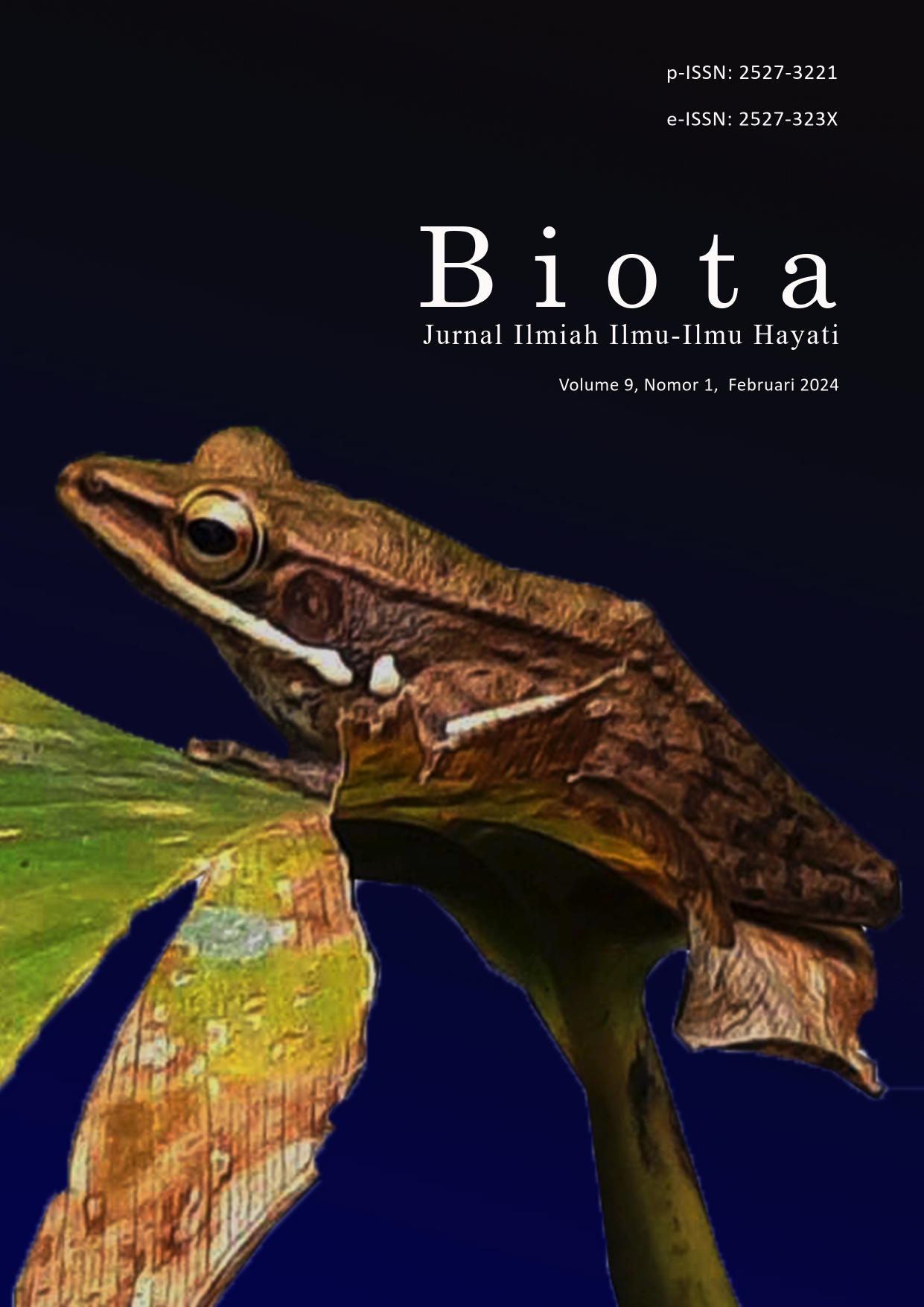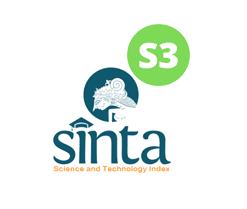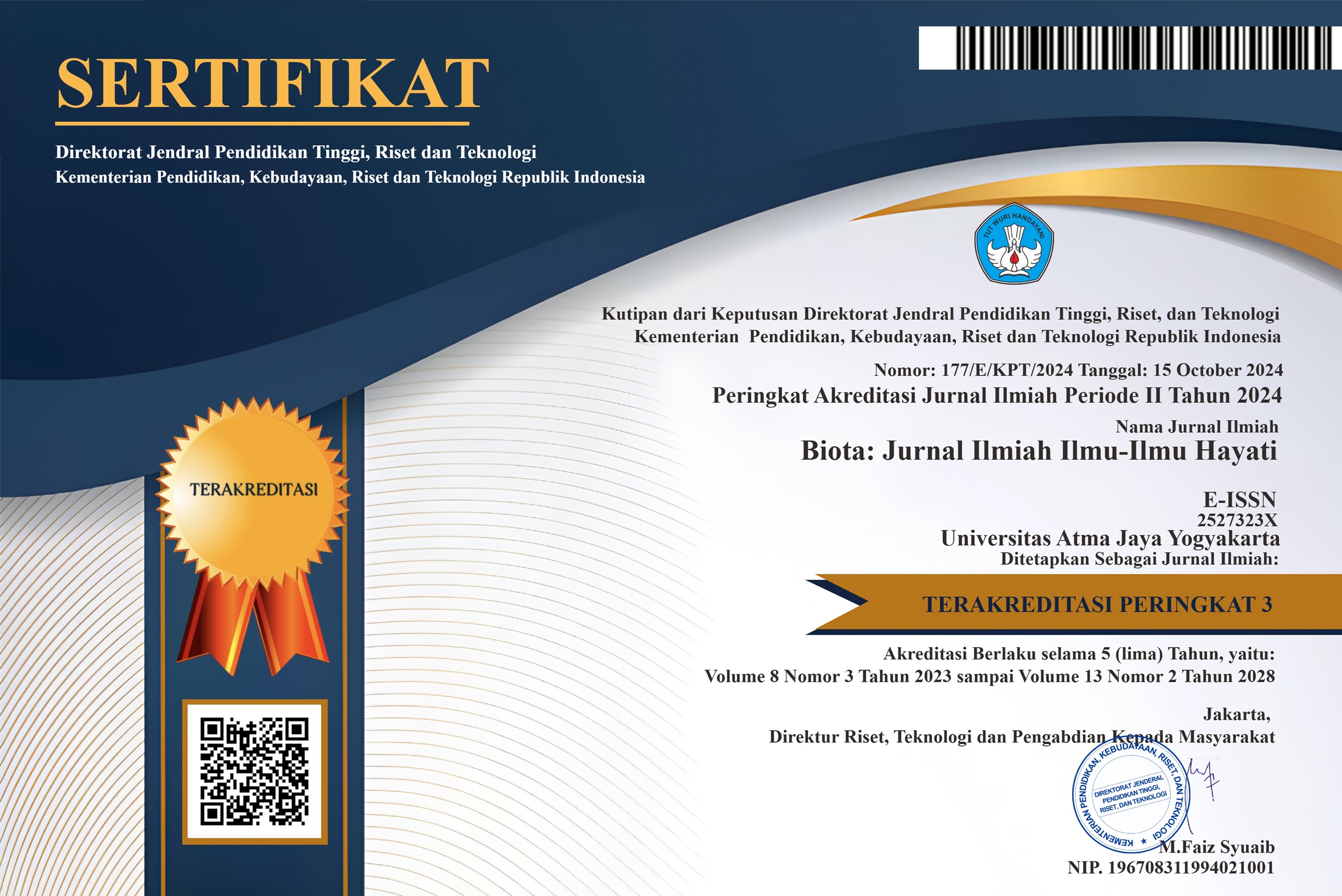Efficacy Study of Eco-Friendly Bleaching Agent for Skeleton Preservation in Animal Skeleton
DOI:
https://doi.org/10.24002/biota.v9i1.8183Keywords:
biology practice, bleaching agent, skeletal animals, skeleton preservationAbstract
The currently used bleaching materials in skeletal preservation are hydrogen and carbamide peroxide materials with specific concentrations and techniques that impact environmental sustainability. This research describes a simple and eco-friendly technique for preserving skeletons. This research used a qualitative approach. Data were collected through observation and documentation. The collected data were analyzed descriptively. The results show that natural extracts, such as lemon combined with baking soda and commercial bleaching cloth agent, can bleach the skull and bone to preserve the skeleton. The commercial bleaching cloth agent is more capable of bleaching animal skulls and bones to preserve skeletons than natural extracts combined with baking soda do; however, the result is more brittle skeletons. Although specimens in lemon extract combined with baking soda solution more slowly clean and bleach skeleton than commercial bleaching solution, skeletal animals have bond strength and environment-friendly processes. This study recommends that an eco-friendly bleaching agent for skeletal preservation should be applied because it can cope with biological practices about osteology and other science subjects.
References
Ahrari, F., Hasanzadeh, N., Rajabi, O., & Forouzannejad, Z. (2017). Effectiveness of sodium bicarbonate combined with hydrogen peroxide and CPP-ACPF in whitening and microhardness of enamel. Journal of Clinical and Experimental Dentistry, 9(3), e344–e350. https://doi.org/10.4317/jced.53108
Allouch, G. (2014). Scientific Technique for Skeletons Preservation and Preparation of (B) (2) (1) (2) (1) (A)
Anatomical Models to Promote Veterinary Anatomy. Journal of Veterinary Anatomy, 7(2), 133–139. https://doi.org/10.21608/jva.2014.44817
Api, A. M., Belsito, D., Bhatia, S., Bruze, M., Calow, P., Dagli, M. L., Dekant, W., Fryer, A. D., Kromidas, L., La Cava, S., Lalko, J. F., Lapczynski, A., Liebler, D. C., Miyachi, Y., Politano, V. T., Ritacco, G., Salvito, D., Schultz, T. W., Shen, J., … Wilcox, D. K. (2016). RIFM fragrance ingredient safety assessment, Eugenol, CAS Registry Number 97-53-0. Food and Chemical Toxicology, 97, S25–S37. https://doi.org/10.1016/j.fct.2015.12.013
Bello, A., & Aisha, Y. (2021). Comparative Osteometric study of some selected bones of local domestic turkey and guinea fowl. Insights in Veterinary Science, 5(1), 008–014. https://doi.org/10.29328/journal.ivs.1001029
Bemis, W. E., Hilton, E. J., Brown, B., Arrindell, R., Richmond, A. M., Little, C. D., Grande, L., Forey, P. L., & Nelson, G. J. (2004). Methods for preparing dry, partially articulated skeletons of osteichthyans, with notes on making ridewood dissections of the cranial skeleton. Copeia, 3, 603–609. https://doi.org/10.1643/CI-03-054R1
Bonney, R., Phillips, T. B., Ballard, H. L., & Enck, J. W. (2016). Can citizen science enhance public understanding of science? Public Understanding of Science, 25(1), 2–16. https://doi.org/10.1177/0963662515607406
Buelo, A., Ghassemi, A., Vorwerk, L., Hooper, W., & Nathoo, S. (2016). Clinical Study to Determine the Stain Removal Effectiveness of a New Dentifrice Formulation. Journal of Clinical Dentistry, 27(3), 80–83.
Chen, T. L., Kim, H., Pan, S. Y., Tseng, P. C., Lin, Y. P., & Chiang, P. C. (2020). Implementation of green chemistry principles in circular economy system towards sustainable development goals: Challenges and perspectives. Science of the Total Environment, 716, 136998. https://doi.org/10.1016/j.scitotenv.2020.136998
Eshach, H., & Fried, M. . (2005). Should science be taught in early childhood? Journal of Science Education and Technology, 14(3), 315–336. https://doi.org/10.1007/s10956-005-7198-9
Gofur, M., & Khan, M. (2010). Development of a Quick, Economic and Efficient Method for Preparation of Skeleton of Small Animals and Birds. Dasnetgroup.Com, 2(7), 13–17. http://dasnetgroup.com/IJBR/data/2010/July/13-17.pdf
Hasan, I., & Islam, M. R. (2019). Preparation of indigenous duck (Anas platyrhynchos) skeleton to enhance veterinary anatomy teaching. Asian Journal of Medical and Biological Research, 5(3), 192–196. https://doi.org/10.3329/ajmbr.v5i3.43587
Hayati, A., Juanengsih, N., & Fadlilah, D. R. (2021). Laboratory activity-based learning to improve generic science skills on the concept of sensory systems. Journal of Physics: Conference Series, 1836(1), 1–9. https://doi.org/10.1088/1742-6596/1836/1/012077
Herrmann, M., Engelke, K., Ebert, R., Müller-Deubert, S., Rudert, M., Ziouti, F., Jundt, F., Felsenberg, D., & Jakob, F. (2020). Interactions between muscle and bone—where physics meets biology. Biomolecules, 10(3), 1–30. https://doi.org/10.3390/biom10030432
Horák, O., Pyszko, M., Páral, V., & Šandor, O. (2022). Degreasing and bleaching bones using light sources as a tool to increase the safety of teaching osteology at the University of Veterinary Sciences Brno. PeerJ, 10, 1–9. https://doi.org/10.7717/peerj.14036
Jamil, N., Jabeen, R., Khan Musarat Riaz, M., Naeem, T., Khan, A., Sabah, N. U., Ghori, S. A., Jabeen, U., Bazai, Z. A., Mushtaq, A., Rizwan, S., & Fahmid, S. (2020). Quantitative Assessment of Juice Content, Citric Acid and Sugar Content in Oranges, Sweet Lime, Lemon and Grapes Available in Fresh Fruit Market of Quetta City. International Journal of Basic & Applied Sciences, 15(1). https://www.researchgate.net/publication/348381824
Jannat, N., Islam, R., & Sultana, N. (2023). Preparing and Presenting a Pigeon Skeleton for Gross Anatomical Study Using Boiling Maceration Method: A Quick and Effective Method. American Journal of Life Science and Innovation, 2(1), 26–32. https://doi.org/10.54536/ajlsi.v2i1.1269
Javid, M. A. (2023). Improvement of veterinary anatomy by using recent scientific techniques for skeleton preparation and preservation. Pure and Applied Biology, 12(2), 848–853. https://doi.org/10.19045/bspab.2023.120084
Jeffers GW. (1943). Formulas for Biological Science. The American Biology Teacher, 6(3), 1–71. https://doi.org/10.2307/4452043
Jeong, S.-J. (2021). Effects of Citrus limon Extract on Oxidative Stress-Induced Nitric Oxide Generation and Bovine Teeth Bleaching . Journal of Dental Hygiene Science, 21(2),
–103. https://doi.org/10.17135/jdhs.2021.21.2.96
Junior, M. T., Rodrigues, C. A., Bernardes, V. L., Berlanga de Araujo, T. S., Antonio Nicoli, G., & dos Reis Derceli, J. (2018). Dental Bleaching and New Possibilities: Literature Review. Health Science Journal, 12(6), 1–6. https://doi.org/10.21767/1791-809x.1000600
Kaliyamoorthy, K., Rajasekhar, S., & Kumar V, D. (2023). Procurement and processing of human bones in medical schools for teaching purpose: A narrative review. Indian Journal of Clinical Anatomy and Physiology, 9(4), 245–251. https://doi.org/10.18231/j.ijcap.2022.052
Kang, H., Lee, S., Kim, J., Park, H., & Kim, S. (2023). Physicochemical characteristics and volatile profile of novel lemon varieties, Minimon and Jeramon. Korean Journal of Food Preservation, 30(5), 770–784. https://doi.org/10.11002/kjfp.2023.30.5.770
Keyes, C. A., Giltrow, K. R., & Mahon, T. J. (2023). A comparison of maceration methods for the preparation of infant skeletal remains for forensic anthropological analysis. International Journal of Legal Medicine, 0123456789, 1–8. https://doi.org/10.1007/s00414-023-03137-4
Li, Y. (2017). Stain removal and whitening by baking soda dentifrice: A review of literature. Journal of the American Dental Association, 148(11), S20–S26. https://doi.org/10.1016/j.adaj.2017.09.006
Mahon, T. J., Maboke, N., & Myburgh, J. (2021). The use of different detergents in skeletal preparations. Forensic Science International, 327, 110967. https://doi.org/10.1016/j.forsciint.2021.110967
Mairs, S., Swift, B., & Rutty, G. N. (2004). Detergent: An alternative approach to traditional bone cleaning methods for forensic practice. American Journal of Forensic Medicine and Pathology, 25(4), 276–284. https://doi.org/10.1097/01.paf.0000147320.70639.41
Malesky, S. M., Horne, A. K., J.S.Pendergraft, & Ross, S. (2009). Evaluation of Two Degreasing Techniques used in Preserving an Equine Skeletal System. Journal of Equine Veterinary Science, 29(5), 477–478. https://doi.org/10.1016/j.jevs.2009.04.169
Marion, P., Bernela, B., Piccirilli, A., Estrine, B., Patouillard, N., Guilbot, J., & Jérôme, F. (2017). Sustainable chemistry: How to produce better and more from less? Green Chemistry, 19(21), 4973–4989. https://doi.org/10.1039/c7gc02006f
Mazur, M., Ndokaj, A., Bietolini, S., Nissi, V., Duś-Ilnicka, I., & Ottolenghi, L. (2022). Green dentistry: Organic toothpaste formulations. A literature review. Dental and Medical Problems, 59(3), 461–474. https://doi.org/10.17219/dmp/146133
Mukka, P. K., Komineni, N. K., Pola, S., Soujanya, E., Karne, A. R., Nenavath, B., Shiva, S., & Vuppunuthula, P. (2016). An in-vitro comparative study of shear bond strength of composite resin to bleached enamel using three herbal antioxidants. Journal of Clinical and Diagnostic Research, 10(10), ZC89–ZC92. https://doi.org/10.7860/JCDR/2016/19262.8676
Mukund, K., & Subramaniam, S. (2020). Skeletal muscle: A review of molecular structure and function, in health and disease. Wiley Interdisciplinary Reviews: Systems Biology and Medicine, 12(1), 1–46. https://doi.org/10.1002/wsbm.1462
Müller-Heupt, L. K., Wiesmann-Imilowski, N., Kaya, S., Schumann, S., Steiger, M., Bjelopavlovic, M., Deschner, J., Al-Nawas, B., & Lehmann, K. M. (2023). Effectiveness and Safety of Over-the-Counter Tooth-Whitening Agents Compared to Hydrogen Peroxide In Vitro. International Journal of Molecular Sciences, 24(3). https://doi.org/10.3390/ijms24031956
Muslim, I., & Inayah, K. (2018). Penggunaan Pemutih Pakaian Komersial (BAYCLIN) Sebagai Zat Etsa Alternatif Pada Pencapan Etsa Kain Kapas Yang Telah Dicelup Zat Warna Reaktif Dingin (Drimarene Blue K2-RL). Prosiding Seminar Nasional I Hasil Litbangyasa Industri, 15–20.
Nuangchalerm, P., & El Islami, R. A. Z. (2018). Comparative study between Indonesian and Thai novice science teacher students in content of science. Journal for the Education of Gifted Young Scientists, 6(2), 23–29. https://doi.org/10.17478/JEGYS.2018.75
Prachagool, V., Nuangchalerm, P., Subramaniam, G., & Dostál, J. (2016). Pedagogical decision making through the lens of teacher preparation program. Journal for the Education of Gifted Young Scientists, 4(1), 41–52. https://doi.org/10.17478/JEGYS.2016116351
Ram, S. (2023). Non-Peroxide Bleaching Materials: A Review. Journal of Pharmaceutical Negative Results ¦, 14(02), 503–507. https://doi.org/10.47750/pnr.2023.14.02.64
Ramos, C. M., Bim Junior, O., Rodrigues, R. F.,
Maenosono, R. M., Alencar, M. S., Wang, L., & Borges, A. F. S. (2014). Bonding to bleached enamel treated with 10% sodium bicarbonate: a one-year follow-up. Brazilian Dental Science, 17(4), 119–124. https://doi.org/10.14295/bds.2014.v17i4.1046
Ritter, B. A., Small, E. E., Mortimer, J. W., & Doll, J. L. (2018). Designing Management Curriculum for Workplace Readiness: Developing Students’ Soft Skills. Journal of Management Education, 42(1), 80–103. https://doi.org/10.1177/1052562917703679
Šafranko, S., Šubarić, D., Jerković, I., & Jokić, S. (2023). Citrus By-Products as a Valuable Source of Biologically Active Compounds with Promising Pharmaceutical, Biological and Biomedical Potential. Pharmaceuticals, 16(8). https://doi.org/10.3390/ph16081081
Savarkar, S., Sankar, J., & Andrea, F. M. (2019). Efficacy Study of whitening Toothpaste containing Lemon (Citrus Limon (L) and Salt (Sodium Carbonate). Online Journal of Dentistry & Oral Health, 2(3), 2–5. https://doi.org/10.33552/ojdoh.2019.02.000538
Simonsen, K. P., Rasmussen, A. R., Mathisen, P., Petersen, H., & Borup, F. (2011). A fast preparation of skeletal materials using enzyme maceration. Journal of Forensic Sciences, 56(2), 480–484. https://doi.org/10.1111/j.1556-4029.2010.01668.x
Soares, D. G., Basso, F. G., Pontes, E. C. V., Garcia, L. D. F. R., Hebling, J., & De Souza Costa, C. A. (2014). Effective tooth-bleaching protocols capable of reducing H2O 2 diffusion through enamel and dentine. Journal of Dentistry, 42(3), 351–358. https://doi.org/10.1016/j.jdent.2013.09.001
Soares, D. G., Marcomini, N., Duque, C. C. de O., Bordini, E. A. F., Zuta, U. O., Basso, F. G., Hebling, J., & Costa, C. A. de S. (2019). Increased whitening efficacy and reduced cytotoxicity are achieved by the chemical activation of a highly concentrated hydrogen peroxide bleaching gel. Journal of Applied Oral Science, 27, 1–10. https://doi.org/10.1590/1678-7757-2018-0453
Steadman, D. W., DiAntonio, L. L., Wilson, J. J., Sheridan, K. E., & Tammariello, S. P. (2006). The effects of chemical and heat maceration techniques on the recovery of nuclear and mitochondrial DNA from bone. Journal of Forensic Sciences, 51(1), 11–17. https://doi.org/10.1111/j.1556-4029.2005.00001.x
Thompson, M. C. (2015). Preparing Skeletons for Research and Teaching from Preserved Human Specimens (Issue December). California State University, East Bay.
VanCleave,J. (2010). How to prepare a chicken skeleton. Available: http://scienceprojectideasforkids.com.
Downloads
Published
How to Cite
Issue
Section
License
Copyright (c) 2024 Muhimatul Umami

This work is licensed under a Creative Commons Attribution-NonCommercial 4.0 International License.
Authors who publish with Biota : Jurnal Ilmiah Ilmu-Ilmu Hayati agree to the following terms:
- Authors retain copyright and grant the Biota : Jurnal Ilmiah Ilmu-Ilmu Hayati right of first publication. Licensed under a Creative Commons Attribution-NonCommercial 4.0 International License that allows others to share the work with an acknowledgment of the work's authorship and initial publication in this journal.
- Authors are able to enter into separate, additional contractual arrangements for the non-exclusive distribution of the journal's published version of the work (e.g., post it to an institutional repository or publish it in a book), with an acknowledgment of its initial publication in Biota : Jurnal Ilmiah Ilmu-Ilmu Hayati, and as long as Author is not used for commercial purposes.













